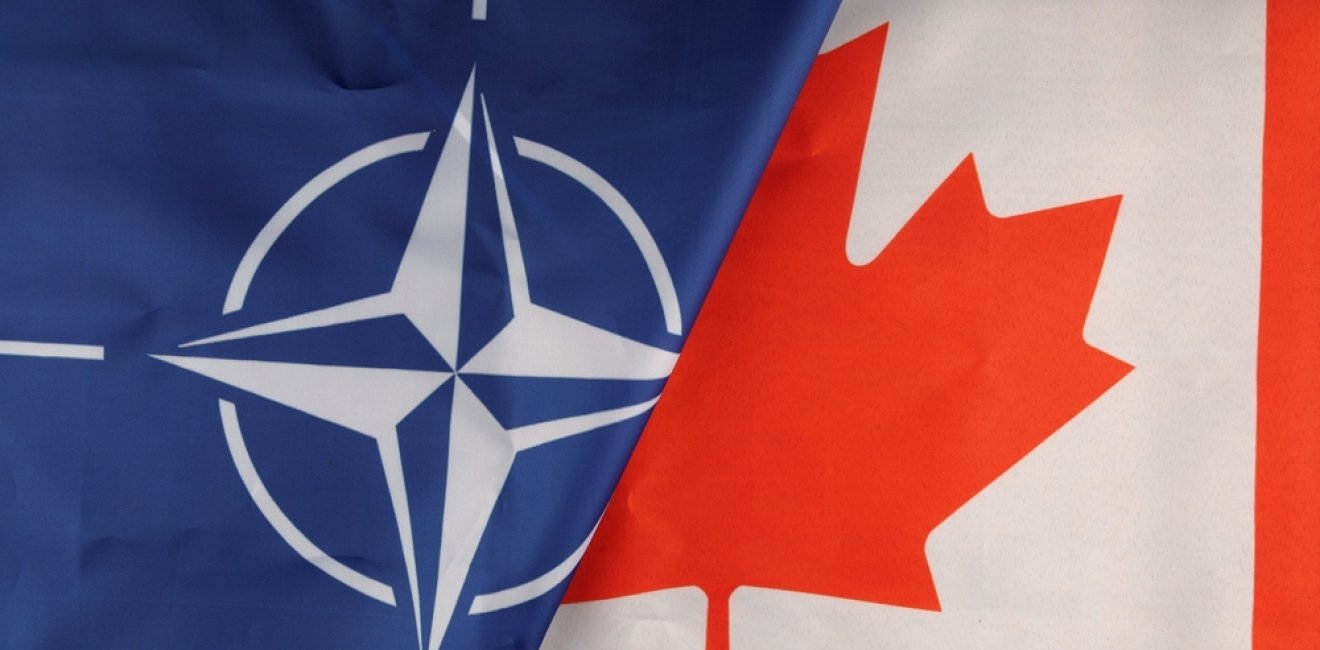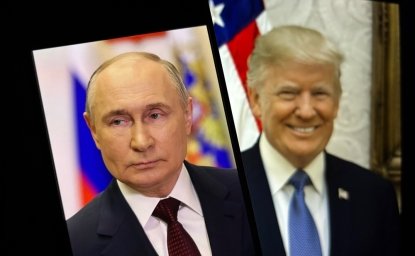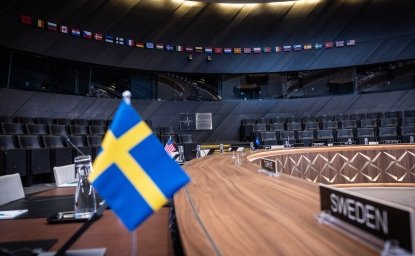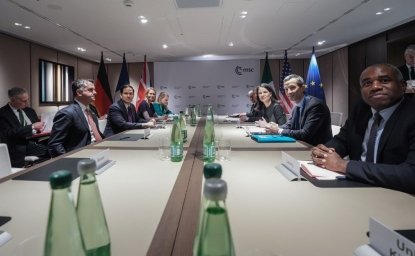As North Atlantic Treaty Organization (NATO) leaders gather in Washington to mark the 75th anniversary of the North Atlantic Treaty, signed in 1949 by US President Harry S. Truman and Canadian Prime Minister Louis St. Laurent, three commitments dominate the agenda. These commitments are the adherence to Article V (an attack on one member is considered an attack on all), the 2014 NATO Wales Defense Investment Pledge (DIP) to aim for spending 2% of Gross Domestic Product (GDP) on defense, and the 2023 NATO Vilnius pledge to ensure members spend a minimum of 2% of GDP on defense.
NATO Secretary General Jens Stoltenberg highlighted these issues during a preview of the summit at the Wilson Center in June. Recent NATO data on alliance defense spending shows that among the 32 NATO allies, only eight spend less than 2% of GDP on defense. Of these, Croatia, Portugal, and Italy spend more than Canada, which only outspends Belgium, Luxembourg, Slovenia, and Spain.
Since NATO’s inception, the United States has consistently urged Canada and European allies to increase their defense spending, a point emphasized in a 2018 US Senate resolution and earlier this year in a letter signed by 23 US Senators. Russia’s 2022 invasion of Ukraine has underscored this need, with more NATO members now meeting or exceeding the 2% GDP defense spending threshold. In 2019, fewer than ten NATO members hit this mark; by 2024, 22 countries had met or exceeded it.
Despite threats from figures like Donald Trump and Vladimir Putin, Canada remains hesitant to increase its defense spending significantly. The latest Canadian budget plans to raise defense spending to 1.76% of GDP by 2030, far below the NATO target. This reluctance raises a crucial question for Washington policymakers: why does the US continue to press Canada on defense spending?
The US persists because, when properly funded and supported, Canada’s military is among the world’s best, demonstrating remarkable courage and tenacity in some of the toughest conflicts of the 20th and 21st centuries.
During World War I, Canada, with a population of less than 8 million, sent 630,000 soldiers to Europe, with 67,000 killed and another 170,000 seriously wounded. Canadian troops played pivotal roles in battles such as Vimy Ridge and Passchendaele.
In World War II, with a population of 11 million (about twice the population of Arizona today), Canada sent one million men and women to fight in Europe and Asia. After the Japanese attack on Pearl Harbor, Canadian forces defended Hong Kong, suffering significant casualties both in battle and as prisoners of war. In Europe, Canadians led the Allied assault on Dieppe and had their own sector on D-Day, known as Juno Beach, where they landed 14,000 troops and provided substantial naval and air support.
The Korean War was Canada’s third-bloodiest conflict, with 516 of the 28,000 Canadian combatants killed in action. Canadians fought in some of the war’s most grueling engagements alongside US, British, Australian, and other Commonwealth forces.
In the 21st century, Canadian Forces joined the NATO mission in Afghanistan following the September 11, 2001, al Qaeda attacks on the United States. Over twelve years, 44,000 Canadian personnel were deployed, with 165 Canadians killed during the war, primarily in the dangerous Kandahar region.
NATO’s most significant battles during the Cold War were those it prevented through deterrence, avoiding a hot conflict. Canadians participated in the Allied occupation of West Germany from 1950 to 1993, with over 100,000 Canadians serving in Germany and parts of France during this period.
Canada also played a crucial role in forming the North American Air Defense Command (NORAD) with the United States in 1957. NORAD's mission was to detect and respond to Soviet threats, including bombers, fighter jets, and missiles. NORAD's importance was underscored when it closed US airspace following the September 11 attacks and again in response to Chinese espionage balloons in 2023. These incidents have prompted a modernization of NORAD’s capabilities, particularly for the Arctic.
Canada’s Cold War contributions, combined with those of the United States and other NATO allies, effectively deterred a direct Soviet attack for 40 years, from NATO’s founding until the fall of the Berlin Wall in 1989. However, the threats to peace and security have evolved. Hostile powers like Russia and China now engage in actions that fall short of direct attacks but still threaten NATO neighbors and partners. These actions necessitate increased spending on monitoring, deterrence, and support for nations under direct attack, draining resources and sapping public morale.
Why has Canada been slow to increase defense spending? Academic literature and expert commentary offer several explanations, but three stand out.
First, Canada has a tradition of negotiation over confrontation. Canadians are negotiators by nature seeking maximum gain for minimum cost. Many key moments in Canadian history were resolved through negotiation rather than force. For instance, after the War of 1812, the US-Canadian border was settled through negotiations and arbitration. Similarly, the westward expansion of settler populations involved negotiations with Indigenous groups, resulting in arguments but rare violence.
Wilfrid Laurier, Canada’s prime minister from 1896 to 1911, exemplified this approach. Confronted with British demands for naval contributions due to German naval expansion, Laurier negotiated the Naval Service Act of 1910, establishing a Canadian navy with limited spending. This compromise satisfied neither Britain nor domestic critics but maintained national unity.
Second, Canadian politicians often lack credibility on national security issues. In the US, national security has broad public support. In Canada, politicians discussing national security may appear to echo American views, making them less credible. US officials might seem more credible but are viewed with suspicion. This dynamic was evident during President George W. Bush’s 2005 visit to Canada, where his call for participation in US missile defenses was ignored.
Third, what the Eurasia Group’s Evan Solomon calls Canadian “insularism”, akin to US isolationism, assumes Canada is insulated from threats by three oceans and the US This false sense of security leads to a reluctance to engage in international conflicts or increase defense budgets. Solomon argues that this insularism, like US isolationism, is a flawed premise that could make Canada less safe.
This context may explain the leaked report in April where Prime Minister Justin Trudeau allegedly told NATO allies that Canada would “never” reach the 2% defense spending target. It might reflect a resigned acknowledgment of political realities rather than indifference. This also explains Conservative Opposition Leader Pierre Poilievre’s lack of detailed foreign policy statements and avoidance of Washington.
Canadian insularism contrasts with the country’s longstanding commitment to multilateral institutions like the United Nations and the G20. However, defending a seat at international tables is easier domestically than justifying increased military spending.
For NATO leaders meeting in Washington, Canada’s reluctance to honor its defense spending commitments is disappointing. Yet, Canada’s past and present military achievements justify continued efforts to secure Canadian contributions to collective security amid escalating threats.
Most Canadian voters are Millennials and Generation Z, for whom the Cold War and much of NATO’s history are distant. They might be more open to supporting increased defense spending if the case is made effectively. Young members of the Canadian Armed Forces, adept with social media, could communicate the importance of national security to their peers. Their firsthand experiences in critical missions could shift public opinion.
Canadian Forces are currently involved in significant NATO operations, such as Operation REASSURANCE in Latvia, Operation UNIFER in Ukraine, and freedom of navigation patrols in the Taiwan Strait and South China Sea. They are also engaged in Operation Prosperity Guardian off the coast of Yemen and a Multinational Security Support mission in Haiti.
These deployments demonstrate the fragility of international peace and security. Canadians on the frontlines of these missions can and should testify first-hand to the necessity of upholding Canada’s commitments to collective security, including NATO, to fellow Canadians. Until then, Ottawa will continue to hear from Washington and other NATO allies that it must meet its defense spending obligations of course. However, change will only come when Ottawa hears this from Canadians voters.






